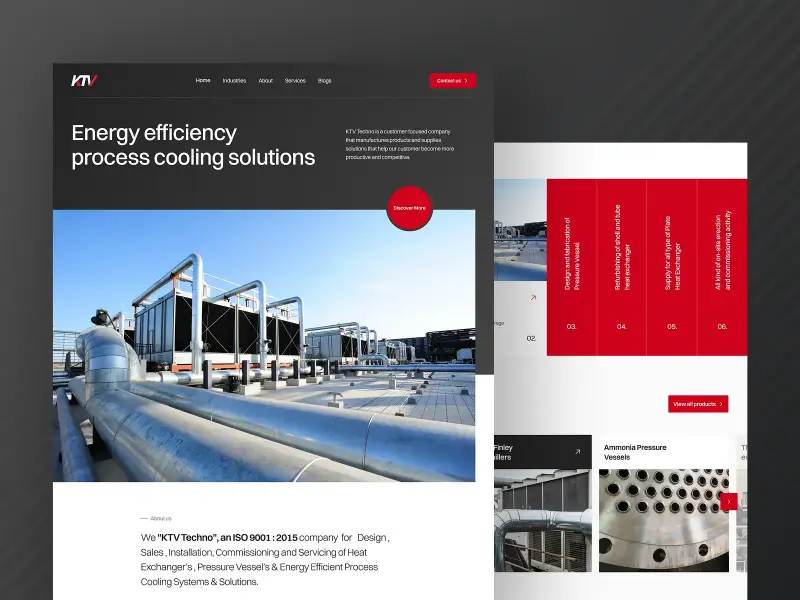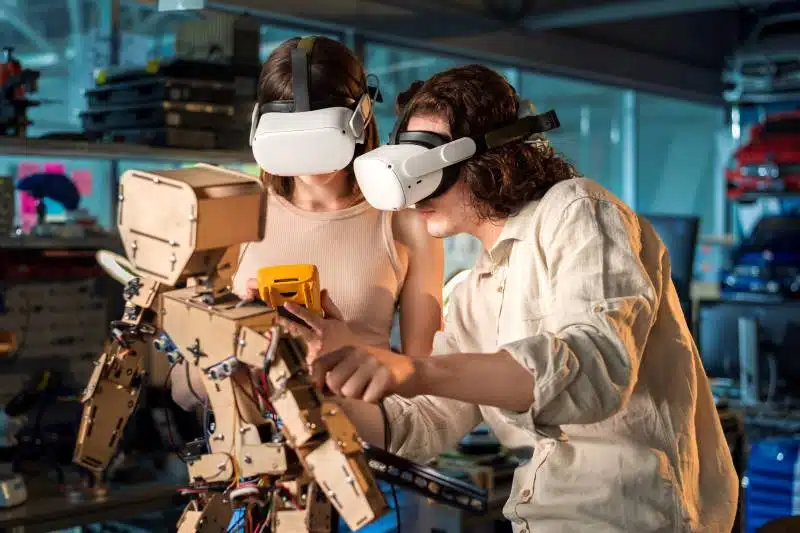Unlock Efficiency With AR in Manufacturing in 2025
- David Ho
- 0 Comments
The manufacturing industry is undergoing a major transformation fueled by rapid advancements in technologies such as artificial intelligence, robotics, and increasingly, augmented reality (AR). Among these innovations, AR stands out as a powerful tool that is reshaping how manufacturers design, assemble, inspect, and train.
In this article, we’ll explore what augmented reality in manufacturing is, how it’s being applied across the industry, highlight real-world examples of its successful implementation, and examine the key benefits AR in manufacturing brings to modern production environments.
What Is AR in Manufacturing?
AR in manufacturing refers to the use of augmented reality technologies in industrial settings to enhance how workers interact with machines, processes, and information. This involves projecting digital content, such as instructions, diagrams, alerts, or sensor data, onto the physical workspace using smart glasses, tablets, or head-mounted displays. The main goal is to provide real-time, hands-free access to critical information while keeping the user’s attention on the task at hand.
Augmented reality in manufacturing
This approach improves operational accuracy, speeds up production, and minimizes human error. It also enhances safety by helping workers follow correct procedures without needing to stop and consult paper manuals or separate screens. In production lines, AR can guide assembly step by step. In maintenance, it can identify faulty parts instantly. In training, it allows new employees to learn procedures through visual, interactive content.
AR in the manufacturing industry is not limited to large corporations. With scalable solutions now available, companies of all sizes can apply AR to solve real problems, improve workflows, and reduce downtime. It’s becoming a core tool for digital transformation across the manufacturing sector.
More Manufacturing Insights:
Market Overview: AR in the Manufacturing Industry
The market for AR in manufacturing is growing rapidly as more companies integrate digital tools into physical operations. ABI Research forecasts that over 28 million AR and mixed reality smart glasses will ship by 2026, generating more than $175 billion in global revenue.
Enterprise adoption is accelerating, with a 66 percent CAGR driven by practical use cases like remote support, virtual training, and real-time maintenance instructions. The pandemic highlighted AR’s value in maintaining operations under pressure, and many manufacturers have kept it in place since.
Major tech companies: Microsoft, Apple, Google, and others, are investing in industrial AR tools. At the same time, augmented reality manufacturing companies are offering scalable, user-friendly platforms that make AR accessible to small and mid-sized manufacturers.
AR improves accuracy, speeds up onboarding, reduces downtime, and supports safer, more efficient workflows.
6 Use Cases of AR in Manufacturing That Are Driving Operational Efficiency
From improving technician support to streamlining logistics, AR in manufacturing is helping companies save time, reduce errors, and boost productivity.
Here are six real-world applications of augmented reality in manufacturing that are making a big difference.
1. Real-Time Support for Field Technicians
Field technicians are often sent to job sites only to realize they are expected to assist with tasks they were not fully prepared for. Without the right knowledge or background, they may struggle to fix the problem. This can waste time, increase costs, and hurt the company’s reputation if the issue is not resolved on the first visit.
With AR in manufacturing, technicians can connect with remote experts in real time. Using smart glasses or mobile devices, they can share their view and receive step-by-step visual guidance. Experts can highlight parts, give instructions, and help solve the issue without sending more staff to the site. This improves first-time fix rates and helps field technicians feel more confident and supported on the job.
2. Boosting Warehouse Efficiency with AR
Warehouse and logistics operations are complex, especially for large companies with massive inventories. Workers often spend up to half of their time just locating the right items. This leads to delays, low efficiency, and costly mistakes.
Augmented reality in manufacturing helps streamline warehouse tasks using head-mounted devices (HMDs). These devices guide workers with real-time visual cues, showing them where to go and what to pick. This reduces search time, improves accuracy, and boosts productivity across the entire operation. For companies in the manufacturing industry, AR is becoming a key tool in improving logistics performance.
AR in manufacturing
3. Smarter Workforce Training with AR
One of the best ways for new technicians and engineers to learn is by working alongside experienced professionals. But many companies are facing a shortage of skilled mentors due to increasing retirements and stretched training resources. As a result, hands-on learning is becoming harder to deliver at scale.
With AR in manufacturing, companies can offer interactive, flexible training no matter where their experts are located. Using digital manuals, 3D AR annotations, and step-by-step standard operating procedures, mentors can guide new hires through complex tasks in real time. This approach helps manufacturers upskill and reskill their teams more efficiently. Augmented reality manufacturing companies are already using this method to preserve knowledge, reduce training time, and keep their workforce aligned with the latest industry standards.
Have a Project Idea in Mind?
Get in touch with experts for a free consultation. We’ll help you decide on next steps, explain how the development process is organized, and provide you with a free project estimate.
4. AR-Powered Equipment Inspections
Regular equipment inspections are critical for keeping machinery running smoothly and ensuring worker safety. Without consistent reviews, small issues can go unnoticed and lead to costly breakdowns or safety risks. Manual inspections, however, can be time-consuming and prone to human error.
Using AR in manufacturing, teams can carry out detailed inspections with real-time guidance and visual support. Through AR-enabled video sessions, operators and safety engineers can access expert input, follow digital instructions, and document findings on the go. This helps improve maintenance planning, reduce repair costs, and enhance operational safety. Augmented reality manufacturing companies are using these tools to make inspections more accurate, efficient, and proactive.
5. Enhancing Quality Audits with AR
Safety and quality are critical priorities in the manufacturing industry. However, conducting consistent safety audits with on-site professionals can be resource-intensive and logistically challenging. In addition, companies must navigate regulations and obtain proper approvals to carry out inspections.
With AR in manufacturing, audits no longer require every specialist to be physically present. Using AR-enabled video collaboration, auditors and safety experts can remotely join inspections and guide teams in real time. They can visually assess workspaces, highlight non-compliance areas, and identify potential risks from any location. This approach helps companies maintain high safety standards while reducing the cost and complexity of traditional audits.
6. Simplifying Equipment Installation with AR
Installing industrial equipment is a complex task that often depends on the availability of skilled engineers. Coordinating schedules, travel, and on-site visits can delay production and increase operational costs.
Augmented reality manufacturing companies are using AR-powered tools to simplify the installation process. Engineers can provide remote guidance using live visuals and step-by-step instructions. Workers on-site can follow these directions in real time, ensuring machines are installed correctly and efficiently. This reduces downtime, eliminates delays, and ensures consistent installation quality across multiple locations.
AR in Manufacturing: Practical Gains on the Factory Floor
AR in manufacturing is solving real production challenges. From precision tasks to faster training, augmented reality in manufacturing is helping companies improve quality, speed, and efficiency.
Automotive Manufacturing
Car production demands flexibility. One plant may build multiple models with different parts and configurations. Workers must switch tasks quickly and get every detail right.
AR in manufacturing provides visual instructions overlaid directly on components. For example, during headliner assembly, AR shows exactly where to place wires, adhesives, and padding. This removes guesswork, reduces errors, and speeds up the process. Even small tasks become more accurate and repeatable.
Manufacturers using AR see faster changeovers, better product quality, and fewer mistakes, without slowing down production.
AR in manufacturing industry
Aerospace & Defense Manufacturing
In aerospace and defense, every assembly must be perfect. Even a small error can compromise safety. Despite the advanced tech in their products, many factories still rely on verbal or written instructions. This creates gaps when experienced workers leave, a growing issue across the industry.
AR in manufacturing replaces tribal knowledge with clear, visual instructions. Workers see each step directly on the part, and systems like LightGuide enforce no-fault-forward logic, tasks must be done correctly before moving on. This reduces errors and supports single-piece flow, where each sub-assembly is completed and passed along. Augmented reality in manufacturing ensures consistency, reduces rework, and speeds up complex processes without sacrificing quality.
Electronics Manufacturing
Electronics manufacturers face tight deadlines and near-zero error tolerance, often under 2%. Most production is outsourced to contractors, who struggle with high turnover and rapid product updates.
AR in manufacturing industry environments solves these challenges with guided, on-the-job training. Workers follow visual instructions that update in real time. Systems like LightGuide’s TrainAR combine training and production in one station, helping new hires learn fast without mistakes. As new devices launch, AR instructions adapt instantly, no need for retraining from scratch.
Augmented reality manufacturing companies help electronics contractors stay efficient, even with frequent changes and high variation. The result: faster onboarding, fewer errors, and consistent output across shifting product lines.
Medical Manufacturing
Medical and pharmaceutical manufacturing must meet strict FDA standards. Every process, whether kitting, pill counting, or drug prep, requires full accuracy to ensure the safety of both workers and patients.
AR in manufacturing strengthens verification by guiding operators through step-by-step visual instructions. Integrated 3D sensors confirm that each action, such as selecting the correct bin, using the right tool, or placing a component properly, is performed correctly before moving forward.
Augmented reality in manufacturing also works with machine vision and sensor technology to validate that all parts are assembled accurately, down to the final screw. This reduces risk, improves compliance, and ensures product integrity in high-stakes environments.
More Manufacturing Insights:
Companies Using AR in the Manufacturing Industry
Across the manufacturing industry, leading companies are adopting Augmented Reality (AR) to enhance efficiency, quality, and safety in their operations. Below are several notable examples of how global manufacturers are successfully integrating AR in manufacturing to solve complex challenges and gain a competitive edge.
Samsung
Samsung uses 3D vision scanning as part of its AR-based inspection process for LCD panels. The scanning system inspects each screen in less than one second and detects both surface and internal defects. By automating what was once a manual process, Samsung increased production line speed, reduced inspection bottlenecks, and improved defect detection. This investment in AR in manufacturing supports higher quality standards, meets rising demand, and ensures consistency across every unit produced without slowing down operations.
Martin-Baker
Martin-Baker partnered with advanced automation providers to improve OEE and manufacturing efficiency. By integrating AR-enabled monitoring systems, they achieved 80 percent OEE. These systems detect tool wear, identify blockages, and automatically adjust job sequences. Real-time alerts are sent to a central control room, allowing teams to respond quickly. This use of AR in manufacturing industry operations helps detect issues early, reduce downtime, and optimize machine performance, ultimately contributing to more reliable and efficient production lines.
BMW
BMW adopted AR in manufacturing by equipping workers at its Munich plant with AR glasses to improve inventory processes. This technology reduced inventory identification time by 22 percent and cut error rates by 33 percent. By overlaying digital instructions onto real-world components, AR helped streamline operations and improve accuracy. Although the initial investment was high, the return in efficiency, speed, and reduced mistakes proved the value of AR, making it a powerful tool for future production strategies.
Porsche
Porsche implemented an AGV-based assembly system for its electric Taycan model. Instead of using a fixed line, vehicles are moved between stations using automated guided vehicles. This allows cars requiring special interior features to exit the main line for custom work. The flexible production layout saves 30 to 40 percent in capital expenses and improves operational efficiency. This approach, supported by AR planning and logistics tools, increases agility, shortens ramp-up times, and supports high-mix, low-volume manufacturing.
Ford
Ford uses high-resolution machine vision combined with AR to inspect painted surfaces for defects. The system includes 16 HD cameras that capture over 1,000 images per surface and build 3D models for detailed inspection. It can detect particles smaller than a grain of salt and review 15 frames per second. This led to a 90 percent reduction in defect rates and improved inspection speed by 50 percent. The shift from manual to automated AR inspection enhances both quality and productivity.
Conclusion
As AR continues to evolve, its role in the manufacturing industry becomes increasingly critical. From enhancing quality control to streamlining operations and reducing downtime, augmented reality in manufacturing is no longer a futuristic concept—it’s a competitive advantage.
If you’re ready to explore how AR can transform your manufacturing operations, TECHVIFY is here to help. Get a free consultation today and discover how AR can drive real results for your operations. Our experts offer tailored AR development solutions designed to meet your business goals.
TECHVIFY – Global AI & Software Solution Company
From Startups to Industry Leaders: TECHVIFY prioritizes results, not just deliverables. Accelerate your time to market and see ROI early with high-performing teams, AI (including GenAI) Software Solutions, and ODC (Offshore Development Center) services.
- Email: [email protected]
- Phone: (+84)24.77762.666







